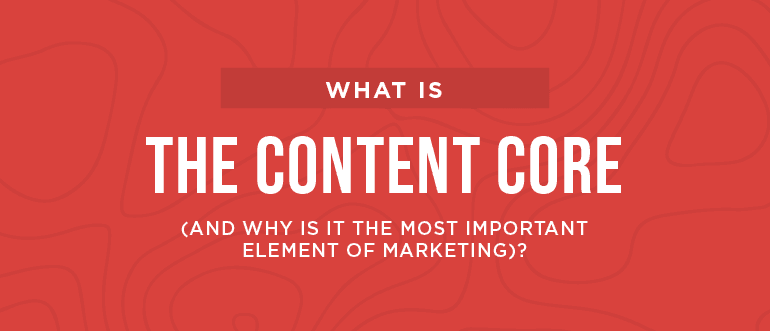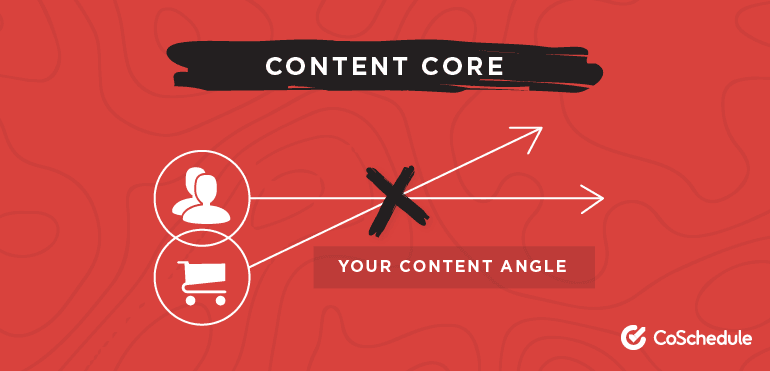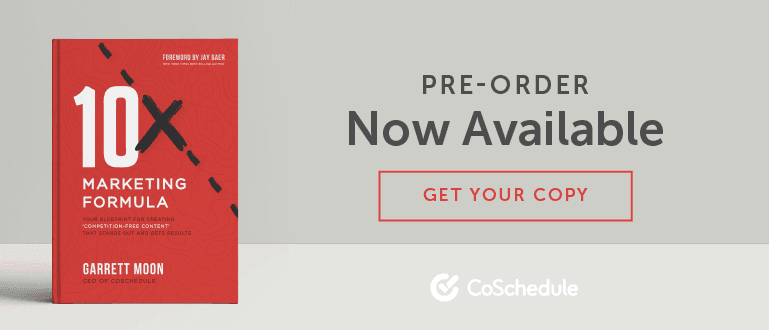What Is The Content Core (And Why Is It The Most Important Element Of Marketing)?
 Right now, grab a notebook or open up a blank document.
Write down the top 3–5 points of your product’s or service’s value proposition. Basically, what are the top reasons your customers buy from you?
Now take a quick look at the content you’ve published in the last month. Is at least one of these value proposition points present in every piece?
If not, your content is at an immediate disadvantage when it comes to producing results.
Here’s why…
Right now, grab a notebook or open up a blank document.
Write down the top 3–5 points of your product’s or service’s value proposition. Basically, what are the top reasons your customers buy from you?
Now take a quick look at the content you’ve published in the last month. Is at least one of these value proposition points present in every piece?
If not, your content is at an immediate disadvantage when it comes to producing results.
Here’s why…
What Is The Content Core (And Why Is It The Most Important Element Of Marketing)?
Click To TweetThe Content Core Is The Most Important Element Of Your Marketing
So, what is the content core exactly? Here’s an explanation from my book, The 10x Marketing Formula:Your content core connects the dots between what your customers care about and what you have to offer them. Notice that I said “what your customers care about,” and not “what your audience cares about.” There’s a difference. Because if you’re going to get really good at generating leads and converting traffic, you have to intimately understand the customers who are already paying you. So, the purpose of the content core exercise is to understand the confluence between what you do and what you need to talk about. Here, you’ll go beyond traffic, eyeballs, and audience building and into creating content that gains customers. Visually, it’s best represented by two overlapping circles. Sitting side-by-side, the circle on the left represents the content your audience cares about. The circle on the right represents the value you provide as a business. The place where the circles overlap is the content core, and is the bullseye of your content strategy. This is content that aligns with your audience’s interests while simultaneously generating demand for your product or service.The Content Core The content core helps marketers avoid two big traps: The Traffic Trap: This trap is creating content your audience cares about, but fails to convert traffic into customers. The danger is that web traffic becomes a false signal. Increasing traffic looks like a positive sign—but revenue doesn’t increase proportionally. The Promotional Trap: This trap is creating a constant barrage of promotional content that fails to connect with your audience’s needs, pains, and interests. The danger with this “me-centric” content is that it adds little, if any, value to an audience. This will fail to generate traffic; and no traffic means no conversions. Finding your content core is like applying guard rails. It helps you avoid either extreme that hamstrings growth. I loop both traps into something called “parallel content.” It’s parallel because that’s exactly what results you’ll achieve: parallel to last year’s (even if they do bring traffic).
The Double Value Of The Content Core
The marketing industry makes a lot of noise about providing value to readers, but if it isn’t balanced by your business’ interests, you’ll be left with no results. Recently, I spoke at a marketing conference about this topic. After my talk, a marketer came and asked some follow up questions. His company was religiously creating blog content that solved their customer’s problems. However, their revenue growth was stagnant, and traffic wasn’t increasing the number of purchases their customers made. So, he asked: “Is it okay to mention our products in our posts? Or will that seem too salesy?” They were blogging about content their customers were interested in. That was great. But, because they never mentioned additional products, the only way for visitors to find out about new or related products was to randomly click on an ad for their online store. This meant their content was helpful to their audience—but not to their business. It was content that drove traffic and added tons of value (the standard recipe for successful content marketing). But it did little to increase profitable customer action. As we talked, I suggested he could start by weaving in contextually relevant call-to-actions (CTAs). His company sells office supplies. So, the CTAs could be as simple as, “Many {company} customers like the {brand} stapler because it doesn’t hurt their fingers to use.” Even a simple CTA like that is a big step forward for his company. While this marketer’s CTA-less content built trust and traffic, it was actually doing his company a disservice. The content core is key here. He had half the equation dialed in because he knew exactly what his audience was interested in. But because he was missing the other half that drives demand, his marketing efforts cost the company more money than they generated. Not to mention, his content became a lot more helpful for the reader who just found a better stapler! The double value of the content core is this: It helps the customer while helping the business.How To Find Your Content Core
So, if your content core is topics your audience is interested that also intersect with your core business. How do you find yours? You’ll start by finding the perfect angles, or points of intersection, between the two. First, to find your content core, I want you to listen directly to your target audience.
This doesn’t need to be fancy. You can use Google, Facebook and LinkedIn user groups, email surveys, or phone calls with your customers.
What you’re looking for are conversations, comments, and questions around the topic you’ll be covering.
You can use Google to research similar content to what you’ll be creating. You can talk directly to your customers about their struggles and problems surrounding your product or service.
With both tactics, your primary goal is to hear how they describe their problems.
First, find popular blog posts and articles on the same, or closely related, topics. Then scroll down to the comments section on each one and read the verbatim statements and questions from people in your target audience.
You’ll pick up the exact phrases they use in relation to the problems you solve. At the same time, you’ll better understand the current gaps where there isn’t a solution.
Second, talk to your customers. Trust me, it’s not as scary as it sounds.
You’ll be full of questions and conversational ammo from your initial research. And this will let you dig even further into the struggles your current customers (AKA: your target audience) face.
Guess what you’ll find? Your unique value proposition. The answers to why people buy your product or service to solve their problems.
From this point, you can directly tailor your content, launches, and campaigns to address each problem.
Each element then represents a point of intersection between the value you provide as a business and what your target audience wants from you.
A great way to express these content core topics is divided into two parts: subject and angle.
The subject is {content core topic}, and the angle is that it will {provide one of the benefits from your value proposition}.
Now, your content can be laser-focused on providing value for everyone involved. This will make your CTAs even more effective because you have both the reason your target audience buys and the language they use to talk about the problems you solve.
First, to find your content core, I want you to listen directly to your target audience.
This doesn’t need to be fancy. You can use Google, Facebook and LinkedIn user groups, email surveys, or phone calls with your customers.
What you’re looking for are conversations, comments, and questions around the topic you’ll be covering.
You can use Google to research similar content to what you’ll be creating. You can talk directly to your customers about their struggles and problems surrounding your product or service.
With both tactics, your primary goal is to hear how they describe their problems.
First, find popular blog posts and articles on the same, or closely related, topics. Then scroll down to the comments section on each one and read the verbatim statements and questions from people in your target audience.
You’ll pick up the exact phrases they use in relation to the problems you solve. At the same time, you’ll better understand the current gaps where there isn’t a solution.
Second, talk to your customers. Trust me, it’s not as scary as it sounds.
You’ll be full of questions and conversational ammo from your initial research. And this will let you dig even further into the struggles your current customers (AKA: your target audience) face.
Guess what you’ll find? Your unique value proposition. The answers to why people buy your product or service to solve their problems.
From this point, you can directly tailor your content, launches, and campaigns to address each problem.
Each element then represents a point of intersection between the value you provide as a business and what your target audience wants from you.
A great way to express these content core topics is divided into two parts: subject and angle.
The subject is {content core topic}, and the angle is that it will {provide one of the benefits from your value proposition}.
Now, your content can be laser-focused on providing value for everyone involved. This will make your CTAs even more effective because you have both the reason your target audience buys and the language they use to talk about the problems you solve.
Why The Content Core Works
Remember my conversation with the ecommerce office supply marketer? He was worried that CTAs would be off-putting and alienate his audience. However, with content core topics, we have found the exact opposite to be true—and so will you. Your content will solve the problem your target audience has—and more importantly, so will your product. In the case of content core topics, your CTA will actually be helpful. So, you’ll actually be doing them a favor. The bottomline is that your content core will help your audience while simultaneously building your business. This is only one facet of The 10x Marketing Formula, but it’s the bedrock for effective marketing.Start Your Journey To 10x Marketing Results
Here’s my challenge to you: Don’t publish another piece of content without ensuring it fits within your content core. If it doesn’t connect the dots between what your customers care about and what you have to offer them, don’t publish it. Parallel topics and subjects that fall outside of your content core will fail to generate revenue. But the stuff that sits in the sweet spot will prove valuable for both your audience and your company. Now, the complete 10x Marketing Formula will be available in early 2018… ...but the good news is there’s no reason you can’t get started today. To those who sign up for our early access list, I’m giving away chapter 1 for free, personally inviting them to our private 10x Marketing LinkedIn Group, and keeping them many steps ahead of everyone else with exclusive pre-publication content. I’ve seen the formula work. I know it will work for you, too. So don’t wait to get results. Start right now.


